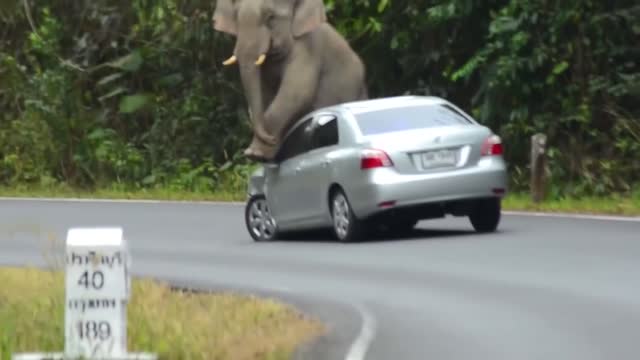Premium Only Content

elephant distroying cars in the roads
Elephant, (family Elephantidae), largest living land animal, characterized by its long trunk (elongated upper lip and nose), columnar legs, and huge head with temporal glands and wide, flat ears. Elephants are grayish to brown in colour, and their body hair is sparse and coarse. They are found most often in savannas, grasslands, and forests but occupy a wide range of habitats, including deserts, swamps, and highlands in tropical and subtropical regions of Africa and Asia.
The African savanna, or bush, elephant (Loxodonta africana) weighs up to 8,000 kg (9 tons) and stands 3 to 4 metres (10 to 13 feet) at the shoulder. The African forest elephant (Loxodonta cyclotis), which lives in rainforests, was recognized as a separate species in 2000 and is smaller than the savanna elephant. It has slender, downward-pointing tusk.
Why Elephant attack and Kills People worldwide ?
ELEPHANTS ARE BEING pushed into smaller and smaller spaces. And increasingly, they're pushing back.According to the National Geographic Channel documentary Elephant Rage, some 500 people are killed by elephant attacks each year. Such attacks are becoming increasingly common, researchers say.
.
"It is a difficult dilemma in areas where elephant habitat is shrinking and the human population is increasing such that poor farmers have little choice but to expand their farms to make ends meet," she said in a telephone interview from a Namibian field camp.
An adult elephant may eat over 400 pounds (180 kilograms) a day. A herd can consume an entire field in one night. Fences and other deterrents are often useless against hungry herds.
Not only can elephants grow as large as about 13 feet (4 meters) tall and weigh as much as about 6 tons, but they can run 25 to 30 miles an hour (40 to 48 kilometers an hour).
Yet despite their size, intelligence, and speed, elephants fare worse in human-elephant confrontations. According to the Elephant Rage documentary, perhaps a thousand elephants are killed each year for their ivory or food, or because they have become a danger to humans living around them.
How to Survive in Elephant Attack
1. Recognize that if the elephant's ears are pinned back it's about to charge. If an elephant's ears are relaxed, it is probably making a mock charge. Ears that are fanned out are likewise indicative of a mock charge. If the elephant's ears are pinned back flat, it is likely that the charge is real.
2. Look at the elephant's trunk to see if it's curled inward in attack position. During a genuine charge, an elephant will curl its trunk up and inward. If its trunk is hanging loosely down, on the other hand, the elephant is probably only making a mock charge.
3. See if the elephant is twitching its trunk or swinging one leg to and fro. These actions are known as “displacement activities.” They're physical signs that show an elephant's indecision regarding whether to charge or mock charge. If you see an elephant doing displacement activities, it's probably about to make a mock charge, not a real charge.
4. Stay downwind from the elephant at all times. This means that the wind should be blowing past the elephant towards you, not past you towards the elephant. When you're downwind, the elephant will find it difficult to smell you and seek you out (elephants have a keen sense of smell). If you can position yourself downwind, you might be able to avoid any further encounter.
5. Run in a zig-zag pattern if the elephant makes a real charge. If an elephant makes a real charge, shouting loudly will not be enough to deter it. If you've noticed the signs of a real charge, start running. A head start, combined with a zig-zag running pattern, should keep you safe from the charge.
-
 0:49
0:49
BANGBizarre
4 years agoSelf-driving cars could hit UK roads in 2021
5 -
 4:48
4:48
KJRH
4 years agoCars stranded underwater and roads closed across Green Country
14 -
 LIVE
LIVE
GritsGG
12 hours agoRumble Customs! 3515 Ws! 🫡!
267 watching -
 5:59:47
5:59:47
SpartakusLIVE
7 hours agoThe HUGEST Brain (not forehead) delivers Saturday SPARTOONS || Variety Later - Shadow of Mordor
176K4 -
 2:34:20
2:34:20
Barry Cunningham
8 hours agoPRESIDENT TRUMP WELCOMES FOOTBALL SEASON! AND MORE BREAKING NEWS!
63.6K41 -
 54:47
54:47
Side Scrollers Podcast
12 hours agoSide Scroller Presents KING OF THE KART | MASSIVE MARIO KART TOURNAMENT
35.9K -
 4:12:33
4:12:33
Mally_Mouse
12 hours ago🔥🍺Spicy HYDRATE Saturday!🍺🔥-- Let's Play: Baldur's Gate!
30.4K1 -
 2:26:32
2:26:32
BooniesHQ
7 hours agoGame Of SKATE Shaun Hover Vs. Jeff DeChesare: Boonies Skate Night 1
105K5 -
 LIVE
LIVE
MissesMaam
2 hours agoAmong Us 3D (ft. Rumblers) 💚✨
79 watching -
 LIVE
LIVE
S0lidJ
3 hours ago🟢Live - S0lidj - Solo Snipes
53 watching